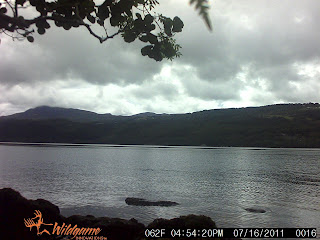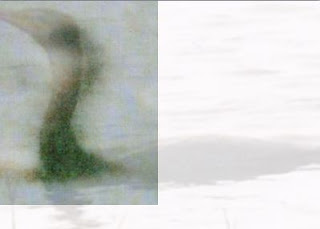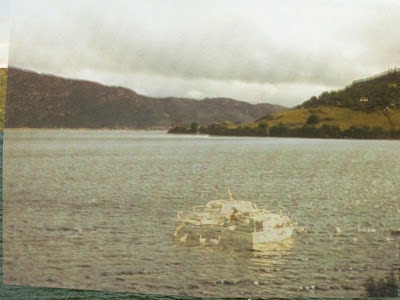You may have noticed this photograph on various Nessie related websites but despite this not a lot is known about this picture taken over thirty years ago. The first mention in the Loch Ness Monster literature is from Rip Hepple in No.54 of his "
Nessletter" which was published in October 1982. The archive link for this issue is
here but we show the relevant extract below (click on image to enlarge).

It is presumed that the picture was taken in August but there is no
certainty about that. The location is the north side of Urquhart Bay, and it looks like it was taken at or near Temple Pier. And that is really it in terms of further information. I tried to obtain the original clipping from the owners of the
Calgary Sunday Sun but without success. I will ask Rip Hepple, but if anyone has a copy of this article, it would be great if they could scan it and email it to me as it could contain relevant information.
The problem is that this photograph appeared in the post-Nessie hunter era. The books by Dinsdale, Holiday, Mackal and so on had been largely written and so it missed the bus, so to speak. However, Henry Bauer mentions it in passing in his 1986 book, "
The Enigma of Loch Ness" but had little to say about it.
In the same year, Steuart Campbell's sceptical book, "
The Loch Ness Monster: The Evidence", did briefly cover the picture but makes no conclusion about it.
Meanwhile, Paul Harrison's excellent book, "
The Encyclopedia of the Loch Ness Monster" does not give it an entry.
BIRDS
So, as you can see, this article is in some sense starting from a low base, but let us see what can be discovered. The zoom in below was obtained from the
Criptosito website and will be used for comparison analysis.

Let us look first at Rip's suggestion that this was merely a bird
swimming or floating on the surface of the loch. Having looked at the
birds mentioned, the best candidate in terms of long neck is the
cormorant of which a representative picture is shown below.
If we superimpose this picture over the Bruce image with a view to equalising the width of the neck bases we see a problem with the bird interpretation. Basically, the bird's head is too big by a factor of at least two. The Bruce image lacks the sharp beak and is an altogether smaller head than what would be expected. Whether a cormorant could also achieve the sinusoidal contours of the Bruce neck is also a matter of debate.
In that light, the bird explanation seems forced and, as I shall point out later, there is another good reason to doubt this interpretation.
SEAGULLS
But another explanation has been suggested by researchers such as Dick Raynor and that is the idea that Jennifer Bruce merely caught a snap of a bird such as a seagull in flight across the loch. Below is a picture of a seagull in a pose not dissimilar to the one suggested (original link
here). To see the suggested bird, the head-neck is the upturned wings in flight and the horizontal base is the tail to beak of the bird.
Let us superimpose this bird over the zoomed in Bruce image to help you see the proposed configuration. Now having seen it, can you see what is wrong with this alleged bird?
Looking at some further pictures of seagulls in flight (below), one is struck by the abnormal nature of the Bruce "seagull". The first abnormality is the position of the mid-wing joint which is too high up. The joint should be nearer the middle of the wing as you can see from the various gull pictures below. This suggests that this is not in fact a seagull at all.
The second problem is the sinusoidal nature of the "wing". Basically, it just does not look right. When a bird is in flight the lower half of the wing does not curve back like the Bruce "wing".The "wing" is also thinner compared to the pictures below.
Thirdly, the Bruce "wing" is disproportionately longer compared to the "body" when compared to the sample gull pictures. All in all, if this is a gull or any other bird, I suggest it is a deformed one which as a consequence is not capable of flight! There are too many problems with this interpretation and the burden of proof lies with the proposer to prove we are looking at a bird.
To see what real seagulls look like at Loch Ness, check this
link. Overlaying the gull in flight at that link over our gull picture produces a nice, proportioned fit.
DETERMINING SIZE
So, taking the position that this is not a bird in flight or at rest on the water, what further can be deduced about the object? Fortunately, I was able to find a similar photograph with a known object in the foreground. The picture below was taken in 1979 at Temple Pier and is reproduced here under the Creative Commons license from the
panoramio website.
From this we can estimate the size of the object in the water by superimposing the Bruce image over the boat image and resizing it to fit the general background contours. As it turns out, there is a person feeding two swans in the centre of the boats who is about the same height as the object. This would mean the proposed head and neck is at least five feet out of the water. The two overlaid images below are to the same scale. As hinted earlier, this is the other reason why this could not be a bird in the water as no bird at Loch Ness has a neck five feet long.
The two relevant sections of the images at the same scale are isolated and shown below for your inspection. If the Bruce object is indeed in the water, it is huge.
As a further confirmation of the scaling, eagle eyed readers may have noticed the two blobs to the far right of the Bruce image. These are most likely two buoys and by a fortunate coincidence, there is a buoy to the right of the boats. When the two pictures are scaled, the buoys in the two pictures are the same size. The shadows on the two Bruce buoys also suggests the photograph was taken around 2pm if we assume mid August as the date. In contrast, the lighter buoy in the boat picture suggests an evening setting.


NOW YOU SEE IT ...
One further consideration is the claim by some commentators that the photographer was not aware of anything unusual when the picture was taken. This is then used to reinforce the case that it was just an everyday object that was ignored at the time (such as a passing bird). However, the Nessletter reference above does not say that the Bruces were unaware of any object at the time. It merely says that when they developed the pictures, a head and neck image was visible.
That is why I would like to see the original source before commenting further. But, if we assume for the sake of argument that they were not aware of anything at the time, it is entirely possible that the photographer did catch a glimpse of something under the restrictions of the viewfinder but it had gone by the time she scanned the loch with the naked eye. Meanwhile, the other two persons may not have even been looking that way as Jennifer Bruce quickly snapped the castle.
Either way, the object, in my opinion, is not a bird. If it was the Loch Ness Monster, then evidently it surfaced for only a short time before submerging again. Flash sightings are not uncommon and the Monster is often been and gone before its audience even realises what is going on. From a Nessie perspective, this would appear to be the case here.
As for the morphology of the creature, the sinusoidal nature of the "neck" is not unusual either. The witness database certainly points to a neck (or whatever the appendage is) possessing a high degree of flexibility. Some witnesses also refer to something akin to musculature rippling or changing though it is unclear what is actually changing under that monstrous skin.
My views have already been
published elsewhere on the supple and subtle nature of what is traditionally considered the head and neck of the Loch Ness Monster. This type of photograph only reinforces that view.
MAKING WAVES
Since this is an object surfacing, one would expect some kind of concentric ripple to emanate from the centre where the object is located. Though the quality of the picture is poor and there are other waves moving up the loch and interfering, I think the ellipse caused by the object is visible as this hand drawn picture tries to demonstrate.
If that is the case, then the ellipse suggests an angle of viewing of 10 degrees and if the observer's eye level is three to four metres above the loch surface then that suggests the object is 17 to 22 metres away. However, this all depends on the accuracy of the ellipse and the elevation of the observer.
The radius of the ellipse is about 9 metres based on our 2 metre neck which suggests the ripple from surfacing has not been travelling very long which is consistent with the creature not being long visible. I would not know for sure how fast such a ripple travels on Loch Ness as it is dependent on the depth of the water at that point and how much force was applied to the water as the object surfaced.
CONCLUSION
So do I consider this a genuine picture of Nessie? Yes, I do. Do I consider explanations about birds inadequate? Yes, I do. Such explanations may have been suggested in good faith, but I fear there has been little in the way of critical analysis of such suggestions.
The internal evidence points away from basic birds towards something big and unidentifiable. There is only one thing big and unidentifiable in Loch Ness ... and we know what that is.









.JPG)


























